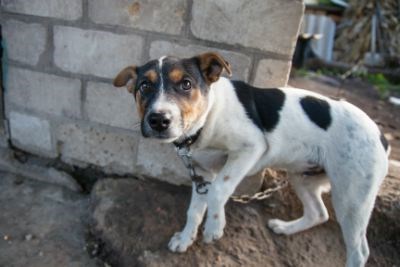Concerned about a neighbour's dog or cat that you see outside? Maybe the animal is tied up, or doesn't have a place to hide from the rain?
You're not alone. Last year, BC SPCA Animal Protection Officers (APOs) responded to 573 calls about tethered animals, and another 725 calls about animals not having any shelter.
What can you do to help that animal? To decide what's next, it is important to understand the laws our APOs must follow. When they visit a property, they must determine if the animal is in distress.
The definition of distress is covered under the legislation that governs the BC SPCA, the Prevention of Cruelty to Animals Act.
It says animals are in distress whenever they're deprived of adequate food, water, shelter, ventilation, light, space, exercise or veterinary care; kept in conditions that are unsanitary; not protected from excessive heat or cold; injured, sick, in pain or suffering; or abused or neglected
Adequate can be a subjective term. Officers use the following definitions to help clarify when they are on site.
Adequate water: Access to clean, potable drinking water at all times
Adequate food: A sufficient quantity of suitable food to allow for normal growth and the maintenance of normal body weight and food receptacles that are clean, disinfected and located as to avoid contamination by excreta
Adequate shelter: A properly constructed shelter that ensures protection from heat, cold and dampness, and is appropriate to the weight and protective outer coat of the animal.
If an animal is tethered, but seems have adequate physical care, your best option is to consider having a conversation with your neighbour. Find out why and how often the animal is tethered outside.
Be open and curious rather than accusatory: consider bringing over some baked goods and use the opportunity to build a relationship, getting to know the neighbour as a fellow animal guardian.
Consider their situation, and what you might do if you were in their same situation. Are there behaviour problems? Is the dog being used as a guard dog?
You can direct them to the BC SPCA's website on "Bringing Your Outdoor Dog Inside".
If the animal appears to be in distress, you can contact our centralized Animal Cruelty Reporting Hotline at 1-855-622-7722 and the call will be dispatched to your local APO. The APO will assess and give the guardian of the animal two options: relieve the distress or surrender the animal.
When you call the Hotline, be sure to have the address of where the animal is located, and a description of the colour, size and breed. It is also helpful to have some documentation of your concerns.
A picture is worth 1,000 words... but words are great too! You can keep a log of what you see regarding food, water, shelter, cleanliness and exercise on a daily basis. How often and how long is the animal tied up a tether? What is the weather like?



